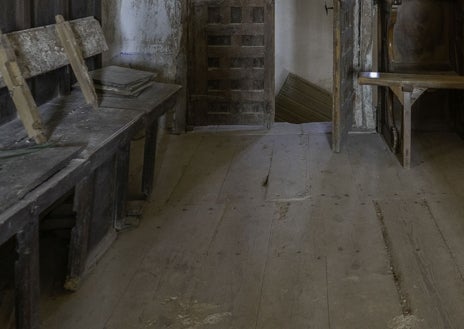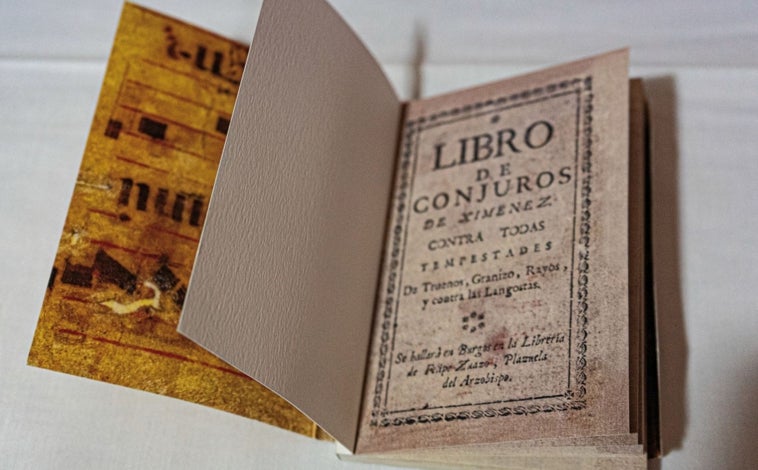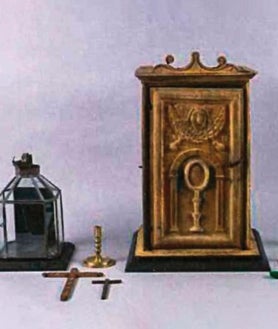The conspiracy of a town of 80 inhabitants to save a jewel of its heritage
-U83856408636tet-1024x512%40diario_abc.jpg&w=1280&q=100)
They have not placed a cross at the foot of the niche of Santa Bárbara to ward off storms and hail, as they do every May 3, nor have they lit a candle in their Conjuradero, the only one in Castilla y León still in use. In Villegas , a small town in Burgos with 79 inhabitants, they have not used this time the ancient book of spells by Pedro Ximénez that they keep in the church of Santa Eugenia . To save the valuable late Gothic choir of this fortress parish, attributable to Francisco de Colonia or his workshop, the cultural association Puentipiedra has launched a crowdfunding campaign with Hispania Nostra , which is one step away from achieving its objective.
With just five days left until the deadline, nearly 200 patrons have already contributed €19,500 , raising the hopes of the people of Villegas. "We thank everyone who has made their contribution and encourage others to join in to restore the splendor of one of the jewels of this magnificent and monumental church ," said Javier Rodríguez, president of the Puentipiedra de Villegas association, in a telephone conversation with ABC.
The choir stalls of this church, declared a Site of Cultural Interest (BIC) in 1991, are closed to parishioners. The risk of the floorboards collapsing forced access to be restricted, and dust, neglect, and the passage of time took hold. Hence, the restoration project, planned with the help and expertise of Antonio de la Fuente, an architect specializing in heritage restoration, plans to begin with this floor, "which is in a truly lamentable state," according to Rodríguez.
The restoration of the original finishes of the two vaults of this upper choir will then be addressed, as well as the restoration of its columns, railings, and other elements. It will also include its artistic lectern . Unlike other temples, this large four-sided lectern, on which sacred books were placed, has been preserved in Villegas' church, although it is severely damaged by woodworm.
-U20132102784Evd-758x470@diario_abc.jpg)

-U12386350103NlL-278x329@diario_abc.jpg)
Its aim is to restore the choir to the shine it had when it was built, 500 years ago , and to restore its functionality. "It would be a magnificent work that we could only achieve if we reach that optimal target of 25,000 euros," notes the president of Puentipiedra. As he explains, it was built in the late 15th or early 16th century and can be attributed to Francisco de Colonia or his workshop, although "its stone front seems almost certainly the work of Simón de Colonia," given the similarities of some elements with those of San Esteban de Burgos, home to the Museo del Retablo .
"These are clues that point, on the one hand, to his undeniable artistic category and, on the other hand, to the need for research on him, a matter we would like to address in the future," Puentipiedra highlights on the crowdfunding website.
The association hopes the Castile and León Regional Government will also collaborate on this project, as the total budget for the project amounts to approximately €40,000 . "If we can't complete everything planned, we'll do what we can, depending on the amount we have obtained. But of course, we'll do everything we can to restore as much as possible," says Rodríguez.
Judging by Puentipiedra's track record, there's no doubt they'll do their best to carry it out, with the close collaboration of the Friends of Villamorón association, which in 2022 secured the financial boost to give its church a second life.
The efforts of this small collective from Villegas, which brings together 90 members, have succeeded in recovering its unique Conjuring Arch, now a museum. "It's the only one in Castile and León that's still in operation," emphasizes the president of Puentipiedra. He also promoted the restoration, by the Simancas Heritage Conservation and Restoration Center, of the "Ximenez's Book of Spells Against All Storms of Thunder, Hail, Lightning, and Locusts" (18th century) and the sacramental elements used in the spells and exorcisms performed from the 16th century until well into the 19th century.

-U32863326623gDx-464x329@diario_abc.jpg)

According to Rodríguez, some of these rites are still maintained today. "On May 3, a cross is placed at the foot of the niche of Santa Bárbara, a candle is lit in the lantern inside the Conjuradero, which remains lit 24 hours a day until September 14, a mass is celebrated, and then a procession to the outskirts of the town to the end of Revilla, where another cross is placed and the fields are blessed."
The Conjuradero (conjuring hall) attached to the Church of Santa Eugenia "is one of the most emblematic and attractive elements of the entire Villegas heritage site ," Rodríguez acknowledges. To perform the spells, the priest used the book of Pedro Ximénez, with different prayers, depending on the danger being addressed, such as the dreaded hail that ruined crops.
The bell ringer assisted in the ritual by ringing the bells. "That ringing created waves that, if the cloud was nearby, could alter its formation so that the storm wouldn't occur. It's scientifically proven that this can happen," adds this Villega resident. Satisfied with the recovery of this space, he now encourages people to contribute to saving the choir. " Donations of up to 250 euros are tax-deductible by 80%," he recalls.
ABC.es



%3Aformat(jpg)%3Aquality(99)%3Awatermark(f.elconfidencial.com%2Ffile%2Fbae%2Feea%2Ffde%2Fbaeeeafde1b3229287b0c008f7602058.png%2C0%2C275%2C1)%2Ff.elconfidencial.com%2Foriginal%2F8c8%2F942%2Fe77%2F8c8942e772a6964d7ca48a8e796cd6f7.jpg&w=1280&q=100)

